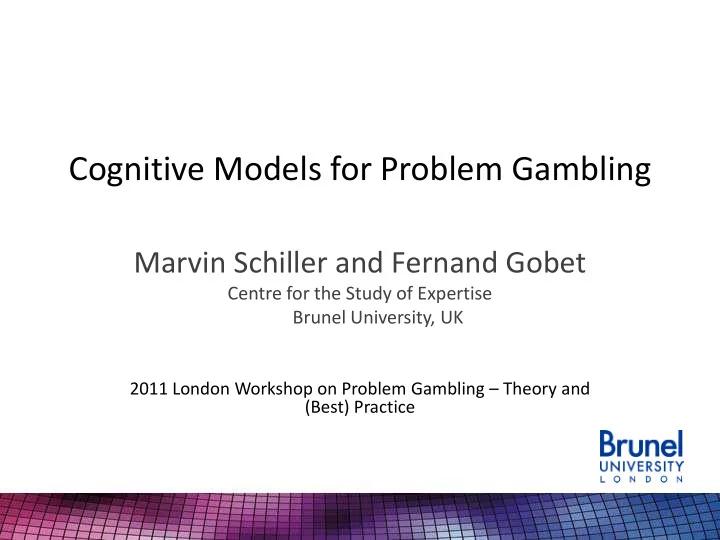

Cognitive Models for Problem Gambling Marvin Schiller and Fernand Gobet Centre for the Study of Expertise Brunel University, UK 2011 London Workshop on Problem Gambling – Theory and (Best) Practice
Overview • Towards Cognitive Models for Problem Gambling • Modelling using CHREST – Iowa Gambling Task – Near Wins • Discussion
Problem Gambling Various fields provide theories/hypotheses/data on PG • Psychiatric & Biological Theories : Interactions between neural, genetic and social factors; comorbidity (anxiety, depression, alcoholism) • Psychological Theories: Conditioning, personality, cognitive biases, e.g. gambler’s fallacy, reinforcement history (near wins, early wins), emotion as a modulator • Integrative Theories: pathways models (e.g. Blaszczynski and Nower, 2002, Sharpe, 2002)
Motivation • Cognitive Modelling – Uses precise formal techniques (e.g. equation systems, computer simulations) to model/explain cognitive processes and behaviour (qualitatively & quantitatively) – Fosters theory development and coherence – Generates testable predictions • Proposed Approach – Models three levels (neural, cognitive, integrative) – Relates PG to established models of perception, learning and decision making
CHREST • A cognitive architecture with a particular focus on visual processing and memory • Computer implementation allows one to develop, run and test models for cognitive processes • Based on chunking theory and template theory • Models of human learning and expertise in various domains, including: – Board games: chess and awale – Language acquisition in children – Physics: creation of diagrams for electric circuits
Components of PG Model Simulation of Memory Action Selection Attention Prediction Environment CHREST STMs Anticipation = Decision Perceptual perception + Making Input BAR LTM retrieval Component LTM Mechanism - Discrimination network - Emotion tags + 0 association learning
Current Modeling • Ensures fundamental results are adequately modeled: – Iowa Gambling Task – Near wins prolong slot machine gambling (e.g. Cote et al., 2003)
Iowa Gambling Task • Models for reward and decision making: – Each deck evaluated, evaluations updated with each selection (via association/reinforcement learning) – Exploration vs. evaluation determined e.g. by Boltzmann exploration A B C D +100 +100 +50 +50 +100 +100 +50 +50 +100 +100 +50/ +50 /-150 -50 (adapted from Bechara et al., 2000) Expected value/trial: -25 +25
Current Modelling LTM Perception +100 +100/-150 A B C D +100 … +100/ B A C D -150 STM 100 100 150
Current Modelling LTM Perception A +100 +100 +100/-150 A B C D -150 +100 … +100/ B A C D -150 STM 100 100 50 50 100 100 25 150 20 150 150 +100/ -150 A ∆V=α*(λ -V)
Choices in the Iowa Gambling Task Selection of 100 cards Healthy Patients
Slot Machine Gambling • Addictive (cf. e.g. Griffiths et al., 1999) • Persistently popular and highly available • Relatively easy to simulate • Important revenue-generator (cf. Ghezzi et al., 2000)
Slot Machine Modelling LTM +100/-1 0/-1 0/-1 +100/-1 +100 -1 100 1 1 STM association +100/-1 learning 0.2 20 0.2
Near Wins Prolong Gambling • Cote et al (2003): during a losing streak, a higher proportion of 7 near wins leads to more persistence 7 Bar sequence including - 9 wins Part 1 - 12 near wins - 27 losses Games played sequence sequence in part 2 consisting of consisting of Part 2 - 25% near wins - 100% plain - 75% plain losses losses Condition 1 (n=29) Condition 2 (n=30) • Dependent variable: persistence in part 2 Data from Cote et al (2003)
Near Wins Prolong Gambling (II) • Tentative explanation: anticipation when recognising two “nearly winning” symbols 7 0.4 0.1 7 Bar 0.2 0.1 0.1
Perspectives • Modelling of further aspects of PG and their interactions – Modulating effect of emotions on processing (and possibly, bias) – Investigating effect of early wins, further structural characteristics, and their interplay – Question: can systematic biases be learned – or sustained – via specific combinations of parameters? • Connect the model to online (slot-machine) games to make qualitative and quantitative predictions
Discussion • Development of PG is a complex phenomenon on several dimensions • Cognitive models for PG are still lacking, despite benefits • This work allows one to investigate the development of PG as a phenomenon of learning, in particular implicit learning
Recommend
More recommend